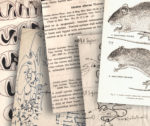Southernmost occurrence of Deltamys kempi (Rodentia, Cricetidae) in Argentina: paleontological and neontological evidence to assess its current distribution
Ulyses F.J. Pardiñas, Martín de los Reyes, Damián Voglino, Carlos A. GalliariWe report the southernmost locality for the sigmodontine rodent Deltamys kempi Thomas, 1917, in Arroyo Las Tijeras (36° 22′ 43″ S, 56° 50′ 12″ W, General Lavalle county) near the coast of Buenos Aires province (Argentina), extending the range of the species ca. 150 km S. This record is a wake-up call about the presence of Brazilian fauna well beyond their southernmost suspected limit. Several lines of evidence point to considering D. kempi as a very recent immigrant in Argentina.
Registro más austral de Deltamys kempi (Rodentia, Cricetidae) en Argentina: evidencia paleontológica y neontológica para evaluar su distribución. Reportamos la localidad más austral para el roedor sigmodontino Deltamys kempi Thomas, 1917: Arroyo Las Tijeras (36° 22′ 43″ S, 56° 50′ 12″ O, Partido de General Lavalle), cerca de la costa de la Provincia de Buenos Aires (Argentina), extendiendo el rango geográfico de la especie ca. 150 km hacia el sur. Este registro constituye una llamada de alerta acerca de la presencia de fauna brasílica bastante más al sur que lo sospechado. Varias líneas de evidencia indican que D. kempi puede ser un inmigrante muy reciente en la fauna argentina.
